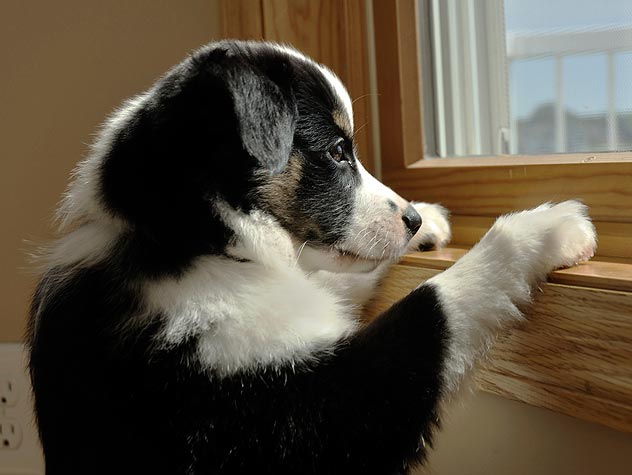De volta à escola Ansiedade de separação

O ano escolar está começando de novo, e é um momento excitante para as crianças e os pais. As crianças começam a ver seus amigos da escola novamente, continuando a desenvolver esses laços sociais estimados, e recheio em alguma educação aqui e ali, enquanto os pais têm a casa de volta para si mesmos por alguns meses. No entanto, de volta ao tempo escolar não é uma grande festa para cada membro da família. Animais de estimação, especialmente novos animais de estimação, que não estão acostumados a gastar muito tempo sozinho pode encontrar-se perturbado com a falta de atenção diária e empresa que eles se acostumaram ao longo dos meses de verão. Isso pode levar a todos os tipos de travessura, caos e danos indesejáveis à propriedade. Então, considerando a temporada, decidimos revisitar um tema oportuno e falar sobre cães com ansiedade de separação.
Separation anxiety is a serious condition for dogs that can cause a lot of suffering. As extremely social animals, pack life is vital to a dog’s mental and social wellbeing. Puppy separation anxiety can be especially severe, so it’s important to take cautionary measures to keep a young pup from suffering unnecessarily. If symptoms are ignored, you’ll be in for a great deal of expense and time spent cleaning up tantrum related messes. An anxious dog will try anything to get out of the house so they can find their owners. That means wrecking blinds, chewing walls, and other general mischief.
To minimize a dog’s discomfort and prevent the expense involved in repairing chewed up baseboards, it can sometimes be necessary to take some precautionary measures. Here is a short list of preparations you can enact to keep your pet’s anxiety to a minimum.
Como ajudar um cão com ansiedade de separação

Mas mais do que criar a ilusão de presença humana, a melhor coisa que você pode fazer para o seu cão é dar-lhe alguma estrutura. Este é o treinamento do filhote de cachorro 101, mas o simples ato de dar comandos e recompensar o bom comportamento reforça cada outra medida que você pode tomar com seu cão.
A simple yet effective technique for getting your dog used to you leaving and returning is to conduct mock excursions. This means getting ready to leave, perform your whole routine, suit up, put on your shoes, grab your keys/wallet/what have you, and walk out the door. Wait a few moments, and then return. Each time your perform this exercise, extend the amount of time between leaving and returning. This will reassure the dog that you will always come back.
You also need to master the ritual of leaving and returning. In general, it’s not a great idea to make a big deal out of it. Don’t dramatize things by stopping, stooping, and showering your dog with affection. Get your things and get out of dodge. The same goes for returning. Come in and handle your business before acknowledging your dog’s welcoming onslaught of slobbery kisses. If this feels too cold, you’re welcome to leave with a parting word. Though this is mostly for your benefit, the dog doesn’t really mind if you forget to say goodbye, just so long as you come back and provide food, water, and lots of affection.
Você também deve deixar algo para o seu cão para fazer enquanto você estiver ausente. Meu favorito pessoal é embalar um brinquedo cheio de manteiga de amendoim e deixar o filhote ir para a cidade. Embora isso esteja longe da única opção disponível para você.
Se você tentar estas várias coisas, e nada parece ajudar, provavelmente é hora de procurar aconselhamento veterinário. Se seu cão não está respondendo a estes métodos diferentes, deve sofrer da ansiedade severa da separação, e necessitará ser endereçado por uns métodos mais fortes, melhor determinados por uma conversação entre você e seu vet.
That’s all for now. Have fun at all the back to school functions and fall fun that accompany this busy season!





 All posts
All posts Tips and Tricks
Tips and Tricks Health and Welling
Health and Welling Revisão de produtos
Revisão de produtos Funny and Quirky
Funny and Quirky





